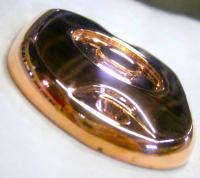Copper plating
This article needs additional citations for verification. (January 2021) |

Copper plating is the process of plating a layer of copper electrolytically on the surface of an item. It takes place in an electrolytic cell where electrolysis which uses direct electric current to dissolve a copper rod and transport the copper ions to the item. Into a container of water are placed a copper rod, and the item. The water contains an ionic solution which allows a direct electric current to flow from the copper rod to the item. The copper rod is the anode and the item is the cathode. This current flow causes the copper to ionize, become oxidized which means each atom becomes positively charged by losing an electron. As the copper ions dissolve into the water, they form a coordination complex with salts already present. The copper then physically flows to the item, where it is reduced to the metallic state by gaining electrons. This forms a thin, solid, metallic copper film on the surface of the item.
Complexing agents[]
There are three primary chemicals used as the complexing agents.: either cyanide, or sulfuric acid, or pyrophosphate. In addition fluoroborate, and proprietary mixtures are used.
Current control[]
It is important to control the current to produce the smoothest copper surface possible. With a higher current, hydrogen bubbles will form on the item to be plated, leaving surface imperfections. Often various other chemicals are added to improve plating uniformity and brightness. These additives can be anything from dish soap to proprietary compounds. Without some form of additive, it is almost impossible to obtain a smooth plated surface.
The surface formed always needs to be polished to achieve a shine. As formed it has a matte luster.
Toxicity[]
Commercial platters typically use a copper-cyanide solution, which retains a high concentration of copper. However, it is inherently dangerous, due to the highly toxic nature of cyanide.
Cyanide bath[]
Cyanide based bath chemistry produces a metal finish favored for its diffusion blocking character. Diffusion blocking is used to improve the long term adherence of different metals, e.g. chromium and steel. It is also used to prevent second material from diffusing into the substrate.
Demonstration of copper plating[]
Copper pennies are useful in demonstrating the concept of copper plating. A simple lemon bath is used to demonstrate this process. Lemon juice is a natural acid that attacks the oxidized copper-oxygen bond, releasing it from the surface of the pennies. Placement of a metal such as an iron nail in the lemon bath containing suspended copper ions results in a simple copper plating of the iron nail.
The uses of copper plating[]
Copper plating material surfaces presents a number of advantages to substrates. The primary reason for copper plating is to improve the conductivity of a substrate, copper is highly conductive - only Silver is a more effective metal at conducting electricity. As a soft metal, copper is also malleable and so has the inherent flexibility to maintain adhesion even if a substrate is subject to being bent and manipulated post plating. When electroplated, copper provides a smooth and even coverage which therefore provides an excellent base for additional coating or plating processes. Corrosion resistance is another advantage to copper. Although copper is not as effective at resisting corrosion as nickel and so is commonly used as a base layer for nickel if enhanced corrosion protection is needed; typically the case for materials that are required to work in marine and subsea environments. Lastly, copper has anti-bacterial properties and so is used in some medical applications.[1]
References[]
External links[]
- Real plating on PTH treated Electroless copper plating on YouTube (responsibly)
- Copper
- Metal plating